Remote Aboriginal Communities in WA: Social Determinants of Health
VerifiedAdded on 2022/09/22
|13
|3750
|52
Essay
AI Summary
This essay critically analyzes the health issues faced by adults in remote Aboriginal communities in Western Australia, focusing on the social determinants of their health. It highlights that a quarter of Aboriginal people in WA live in very remote areas, facing challenges like limited access to healthcare, poor living conditions, and inadequate municipal services. The essay identifies diabetes as a significant health issue, exacerbated by lifestyle factors and socio-economic status. Key social determinants discussed include racism and lateral violence, socio-economic disadvantage, poor housing conditions, and low levels of education. The essay concludes by emphasizing the need for comprehensive interventions addressing these social determinants to improve the health and well-being of remote Aboriginal communities in Western Australia. Desklib offers a range of study tools and resources to support students in understanding complex health and social issues.
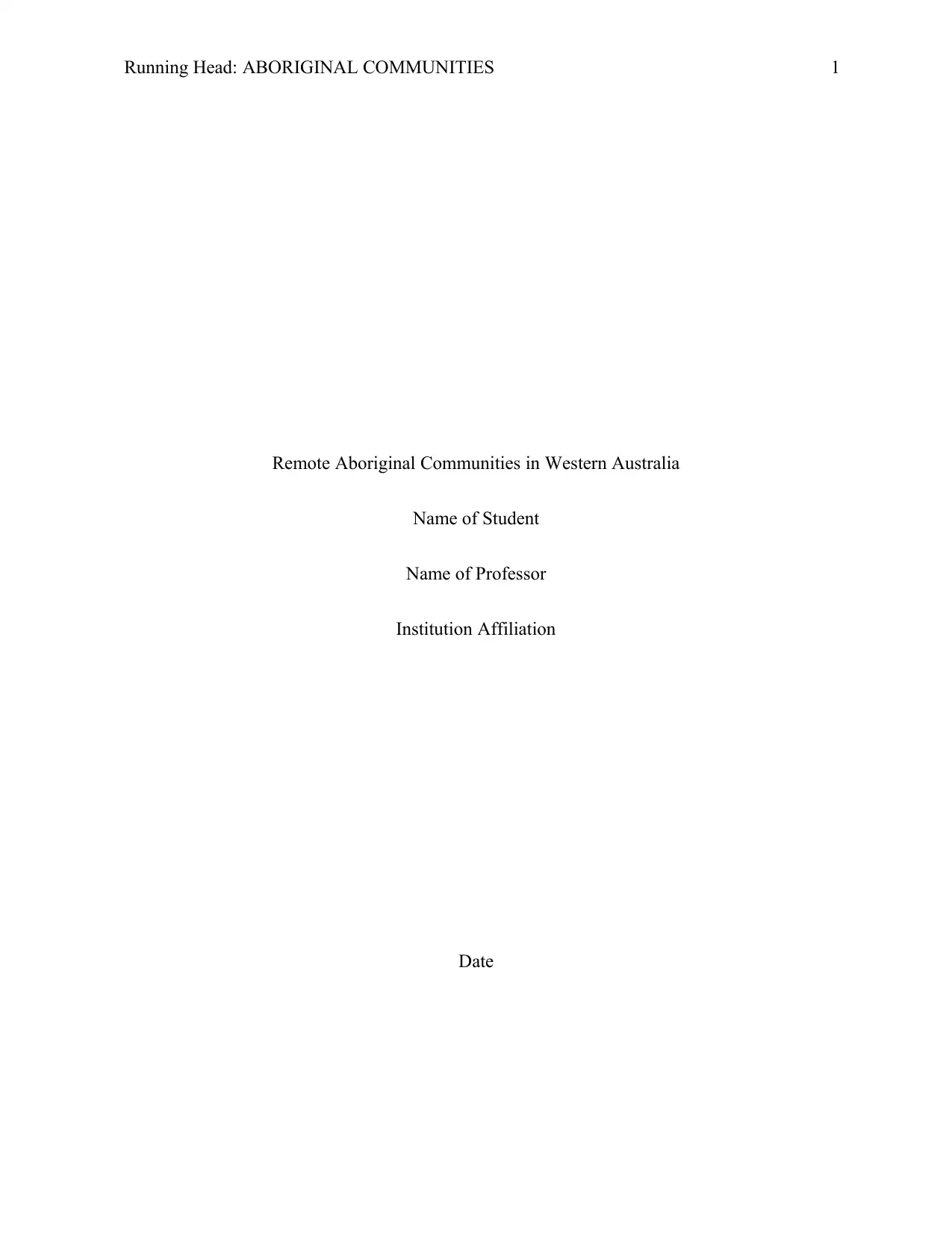
Running Head: ABORIGINAL COMMUNITIES 1
Remote Aboriginal Communities in Western Australia
Name of Student
Name of Professor
Institution Affiliation
Date
Remote Aboriginal Communities in Western Australia
Name of Student
Name of Professor
Institution Affiliation
Date
Paraphrase This Document
Need a fresh take? Get an instant paraphrase of this document with our AI Paraphraser
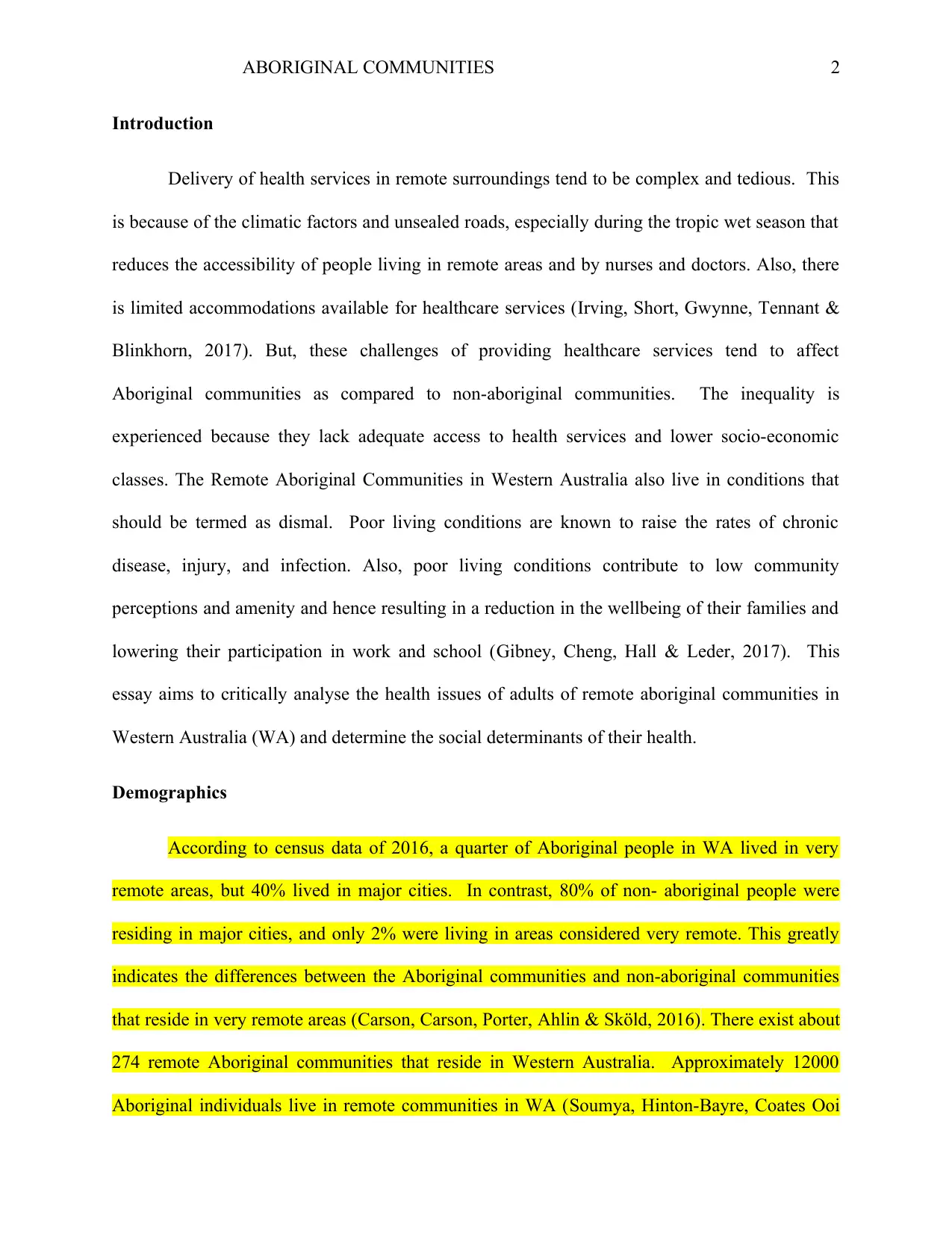
ABORIGINAL COMMUNITIES 2
Introduction
Delivery of health services in remote surroundings tend to be complex and tedious. This
is because of the climatic factors and unsealed roads, especially during the tropic wet season that
reduces the accessibility of people living in remote areas and by nurses and doctors. Also, there
is limited accommodations available for healthcare services (Irving, Short, Gwynne, Tennant &
Blinkhorn, 2017). But, these challenges of providing healthcare services tend to affect
Aboriginal communities as compared to non-aboriginal communities. The inequality is
experienced because they lack adequate access to health services and lower socio-economic
classes. The Remote Aboriginal Communities in Western Australia also live in conditions that
should be termed as dismal. Poor living conditions are known to raise the rates of chronic
disease, injury, and infection. Also, poor living conditions contribute to low community
perceptions and amenity and hence resulting in a reduction in the wellbeing of their families and
lowering their participation in work and school (Gibney, Cheng, Hall & Leder, 2017). This
essay aims to critically analyse the health issues of adults of remote aboriginal communities in
Western Australia (WA) and determine the social determinants of their health.
Demographics
According to census data of 2016, a quarter of Aboriginal people in WA lived in very
remote areas, but 40% lived in major cities. In contrast, 80% of non- aboriginal people were
residing in major cities, and only 2% were living in areas considered very remote. This greatly
indicates the differences between the Aboriginal communities and non-aboriginal communities
that reside in very remote areas (Carson, Carson, Porter, Ahlin & Sköld, 2016). There exist about
274 remote Aboriginal communities that reside in Western Australia. Approximately 12000
Aboriginal individuals live in remote communities in WA (Soumya, Hinton-Bayre, Coates Ooi
Introduction
Delivery of health services in remote surroundings tend to be complex and tedious. This
is because of the climatic factors and unsealed roads, especially during the tropic wet season that
reduces the accessibility of people living in remote areas and by nurses and doctors. Also, there
is limited accommodations available for healthcare services (Irving, Short, Gwynne, Tennant &
Blinkhorn, 2017). But, these challenges of providing healthcare services tend to affect
Aboriginal communities as compared to non-aboriginal communities. The inequality is
experienced because they lack adequate access to health services and lower socio-economic
classes. The Remote Aboriginal Communities in Western Australia also live in conditions that
should be termed as dismal. Poor living conditions are known to raise the rates of chronic
disease, injury, and infection. Also, poor living conditions contribute to low community
perceptions and amenity and hence resulting in a reduction in the wellbeing of their families and
lowering their participation in work and school (Gibney, Cheng, Hall & Leder, 2017). This
essay aims to critically analyse the health issues of adults of remote aboriginal communities in
Western Australia (WA) and determine the social determinants of their health.
Demographics
According to census data of 2016, a quarter of Aboriginal people in WA lived in very
remote areas, but 40% lived in major cities. In contrast, 80% of non- aboriginal people were
residing in major cities, and only 2% were living in areas considered very remote. This greatly
indicates the differences between the Aboriginal communities and non-aboriginal communities
that reside in very remote areas (Carson, Carson, Porter, Ahlin & Sköld, 2016). There exist about
274 remote Aboriginal communities that reside in Western Australia. Approximately 12000
Aboriginal individuals live in remote communities in WA (Soumya, Hinton-Bayre, Coates Ooi
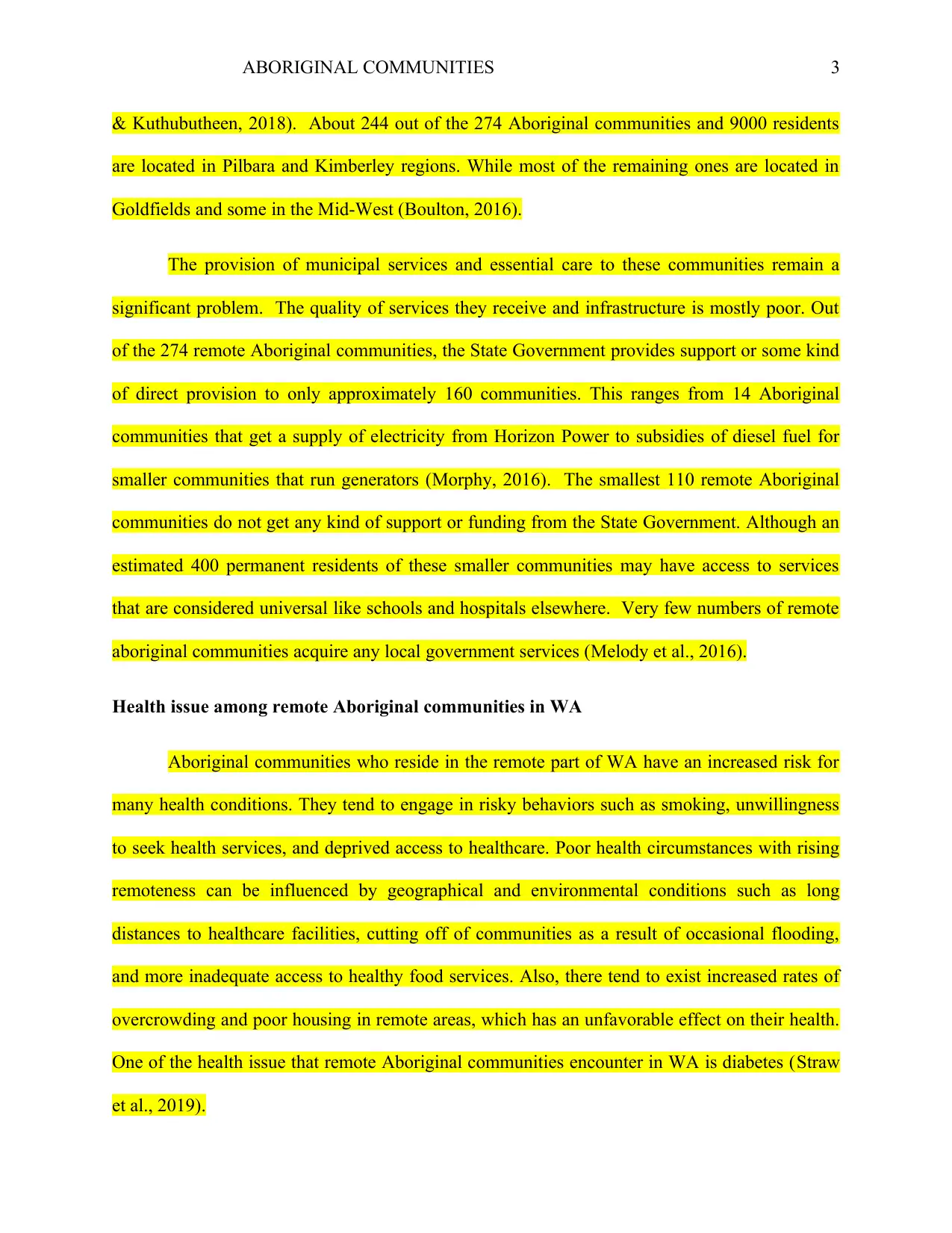
ABORIGINAL COMMUNITIES 3
& Kuthubutheen, 2018). About 244 out of the 274 Aboriginal communities and 9000 residents
are located in Pilbara and Kimberley regions. While most of the remaining ones are located in
Goldfields and some in the Mid-West (Boulton, 2016).
The provision of municipal services and essential care to these communities remain a
significant problem. The quality of services they receive and infrastructure is mostly poor. Out
of the 274 remote Aboriginal communities, the State Government provides support or some kind
of direct provision to only approximately 160 communities. This ranges from 14 Aboriginal
communities that get a supply of electricity from Horizon Power to subsidies of diesel fuel for
smaller communities that run generators (Morphy, 2016). The smallest 110 remote Aboriginal
communities do not get any kind of support or funding from the State Government. Although an
estimated 400 permanent residents of these smaller communities may have access to services
that are considered universal like schools and hospitals elsewhere. Very few numbers of remote
aboriginal communities acquire any local government services (Melody et al., 2016).
Health issue among remote Aboriginal communities in WA
Aboriginal communities who reside in the remote part of WA have an increased risk for
many health conditions. They tend to engage in risky behaviors such as smoking, unwillingness
to seek health services, and deprived access to healthcare. Poor health circumstances with rising
remoteness can be influenced by geographical and environmental conditions such as long
distances to healthcare facilities, cutting off of communities as a result of occasional flooding,
and more inadequate access to healthy food services. Also, there tend to exist increased rates of
overcrowding and poor housing in remote areas, which has an unfavorable effect on their health.
One of the health issue that remote Aboriginal communities encounter in WA is diabetes (Straw
et al., 2019).
& Kuthubutheen, 2018). About 244 out of the 274 Aboriginal communities and 9000 residents
are located in Pilbara and Kimberley regions. While most of the remaining ones are located in
Goldfields and some in the Mid-West (Boulton, 2016).
The provision of municipal services and essential care to these communities remain a
significant problem. The quality of services they receive and infrastructure is mostly poor. Out
of the 274 remote Aboriginal communities, the State Government provides support or some kind
of direct provision to only approximately 160 communities. This ranges from 14 Aboriginal
communities that get a supply of electricity from Horizon Power to subsidies of diesel fuel for
smaller communities that run generators (Morphy, 2016). The smallest 110 remote Aboriginal
communities do not get any kind of support or funding from the State Government. Although an
estimated 400 permanent residents of these smaller communities may have access to services
that are considered universal like schools and hospitals elsewhere. Very few numbers of remote
aboriginal communities acquire any local government services (Melody et al., 2016).
Health issue among remote Aboriginal communities in WA
Aboriginal communities who reside in the remote part of WA have an increased risk for
many health conditions. They tend to engage in risky behaviors such as smoking, unwillingness
to seek health services, and deprived access to healthcare. Poor health circumstances with rising
remoteness can be influenced by geographical and environmental conditions such as long
distances to healthcare facilities, cutting off of communities as a result of occasional flooding,
and more inadequate access to healthy food services. Also, there tend to exist increased rates of
overcrowding and poor housing in remote areas, which has an unfavorable effect on their health.
One of the health issue that remote Aboriginal communities encounter in WA is diabetes (Straw
et al., 2019).
⊘ This is a preview!⊘
Do you want full access?
Subscribe today to unlock all pages.

Trusted by 1+ million students worldwide
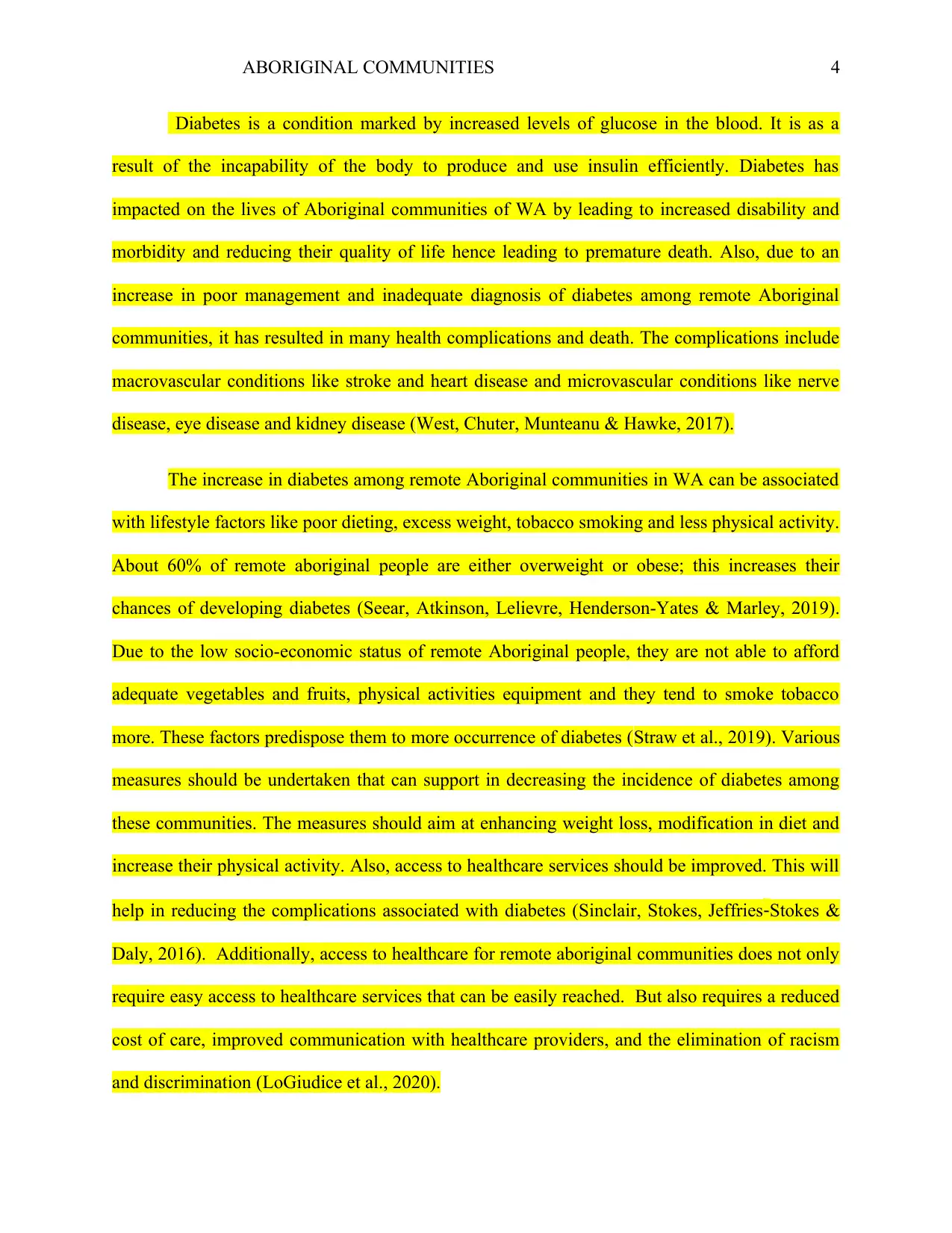
ABORIGINAL COMMUNITIES 4
Diabetes is a condition marked by increased levels of glucose in the blood. It is as a
result of the incapability of the body to produce and use insulin efficiently. Diabetes has
impacted on the lives of Aboriginal communities of WA by leading to increased disability and
morbidity and reducing their quality of life hence leading to premature death. Also, due to an
increase in poor management and inadequate diagnosis of diabetes among remote Aboriginal
communities, it has resulted in many health complications and death. The complications include
macrovascular conditions like stroke and heart disease and microvascular conditions like nerve
disease, eye disease and kidney disease (West, Chuter, Munteanu & Hawke, 2017).
The increase in diabetes among remote Aboriginal communities in WA can be associated
with lifestyle factors like poor dieting, excess weight, tobacco smoking and less physical activity.
About 60% of remote aboriginal people are either overweight or obese; this increases their
chances of developing diabetes (Seear, Atkinson, Lelievre, Henderson-Yates & Marley, 2019).
Due to the low socio-economic status of remote Aboriginal people, they are not able to afford
adequate vegetables and fruits, physical activities equipment and they tend to smoke tobacco
more. These factors predispose them to more occurrence of diabetes (Straw et al., 2019). Various
measures should be undertaken that can support in decreasing the incidence of diabetes among
these communities. The measures should aim at enhancing weight loss, modification in diet and
increase their physical activity. Also, access to healthcare services should be improved. This will
help in reducing the complications associated with diabetes (Sinclair, Stokes, Jeffries‐Stokes &
Daly, 2016). Additionally, access to healthcare for remote aboriginal communities does not only
require easy access to healthcare services that can be easily reached. But also requires a reduced
cost of care, improved communication with healthcare providers, and the elimination of racism
and discrimination (LoGiudice et al., 2020).
Diabetes is a condition marked by increased levels of glucose in the blood. It is as a
result of the incapability of the body to produce and use insulin efficiently. Diabetes has
impacted on the lives of Aboriginal communities of WA by leading to increased disability and
morbidity and reducing their quality of life hence leading to premature death. Also, due to an
increase in poor management and inadequate diagnosis of diabetes among remote Aboriginal
communities, it has resulted in many health complications and death. The complications include
macrovascular conditions like stroke and heart disease and microvascular conditions like nerve
disease, eye disease and kidney disease (West, Chuter, Munteanu & Hawke, 2017).
The increase in diabetes among remote Aboriginal communities in WA can be associated
with lifestyle factors like poor dieting, excess weight, tobacco smoking and less physical activity.
About 60% of remote aboriginal people are either overweight or obese; this increases their
chances of developing diabetes (Seear, Atkinson, Lelievre, Henderson-Yates & Marley, 2019).
Due to the low socio-economic status of remote Aboriginal people, they are not able to afford
adequate vegetables and fruits, physical activities equipment and they tend to smoke tobacco
more. These factors predispose them to more occurrence of diabetes (Straw et al., 2019). Various
measures should be undertaken that can support in decreasing the incidence of diabetes among
these communities. The measures should aim at enhancing weight loss, modification in diet and
increase their physical activity. Also, access to healthcare services should be improved. This will
help in reducing the complications associated with diabetes (Sinclair, Stokes, Jeffries‐Stokes &
Daly, 2016). Additionally, access to healthcare for remote aboriginal communities does not only
require easy access to healthcare services that can be easily reached. But also requires a reduced
cost of care, improved communication with healthcare providers, and the elimination of racism
and discrimination (LoGiudice et al., 2020).
Paraphrase This Document
Need a fresh take? Get an instant paraphrase of this document with our AI Paraphraser
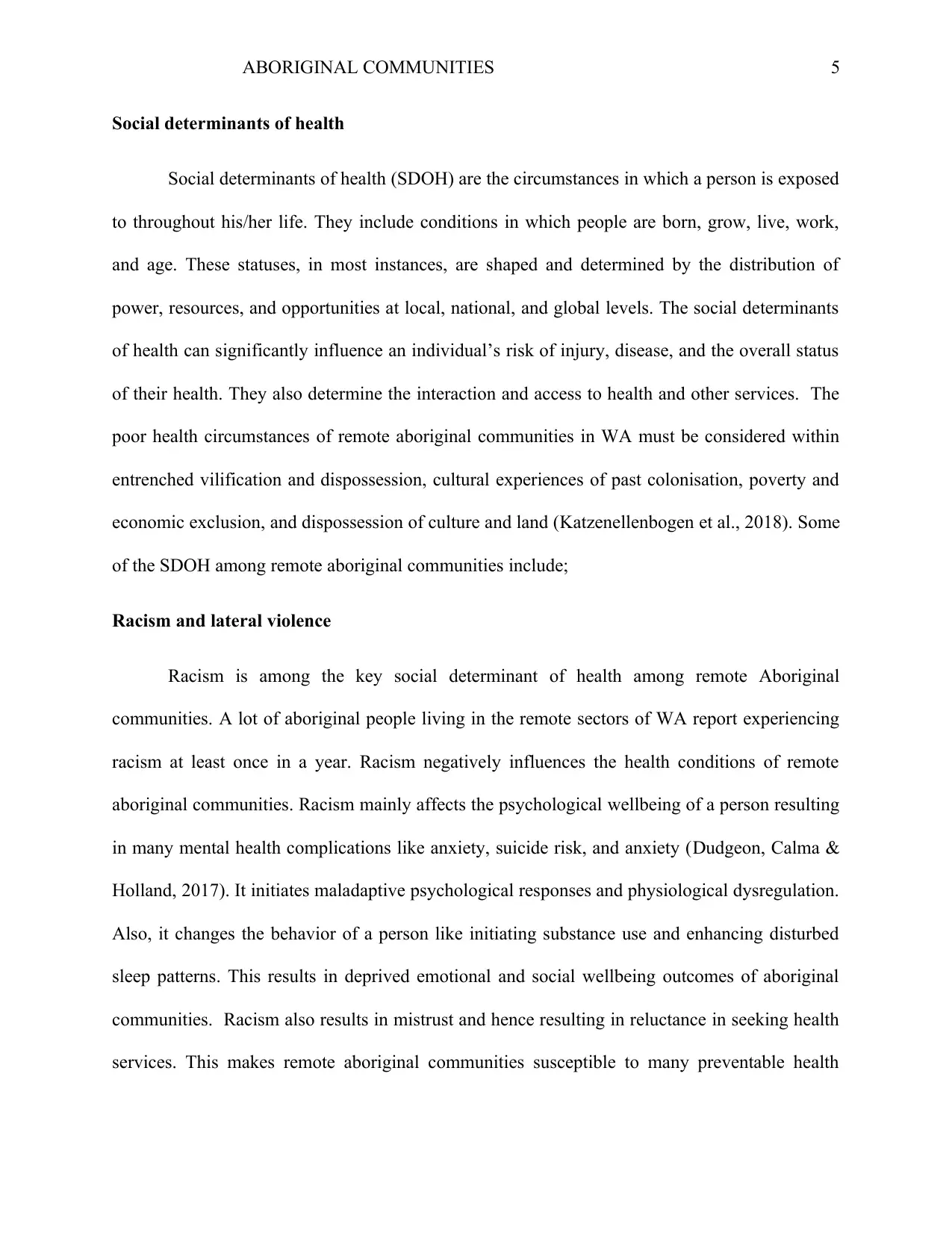
ABORIGINAL COMMUNITIES 5
Social determinants of health
Social determinants of health (SDOH) are the circumstances in which a person is exposed
to throughout his/her life. They include conditions in which people are born, grow, live, work,
and age. These statuses, in most instances, are shaped and determined by the distribution of
power, resources, and opportunities at local, national, and global levels. The social determinants
of health can significantly influence an individual’s risk of injury, disease, and the overall status
of their health. They also determine the interaction and access to health and other services. The
poor health circumstances of remote aboriginal communities in WA must be considered within
entrenched vilification and dispossession, cultural experiences of past colonisation, poverty and
economic exclusion, and dispossession of culture and land (Katzenellenbogen et al., 2018). Some
of the SDOH among remote aboriginal communities include;
Racism and lateral violence
Racism is among the key social determinant of health among remote Aboriginal
communities. A lot of aboriginal people living in the remote sectors of WA report experiencing
racism at least once in a year. Racism negatively influences the health conditions of remote
aboriginal communities. Racism mainly affects the psychological wellbeing of a person resulting
in many mental health complications like anxiety, suicide risk, and anxiety (Dudgeon, Calma &
Holland, 2017). It initiates maladaptive psychological responses and physiological dysregulation.
Also, it changes the behavior of a person like initiating substance use and enhancing disturbed
sleep patterns. This results in deprived emotional and social wellbeing outcomes of aboriginal
communities. Racism also results in mistrust and hence resulting in reluctance in seeking health
services. This makes remote aboriginal communities susceptible to many preventable health
Social determinants of health
Social determinants of health (SDOH) are the circumstances in which a person is exposed
to throughout his/her life. They include conditions in which people are born, grow, live, work,
and age. These statuses, in most instances, are shaped and determined by the distribution of
power, resources, and opportunities at local, national, and global levels. The social determinants
of health can significantly influence an individual’s risk of injury, disease, and the overall status
of their health. They also determine the interaction and access to health and other services. The
poor health circumstances of remote aboriginal communities in WA must be considered within
entrenched vilification and dispossession, cultural experiences of past colonisation, poverty and
economic exclusion, and dispossession of culture and land (Katzenellenbogen et al., 2018). Some
of the SDOH among remote aboriginal communities include;
Racism and lateral violence
Racism is among the key social determinant of health among remote Aboriginal
communities. A lot of aboriginal people living in the remote sectors of WA report experiencing
racism at least once in a year. Racism negatively influences the health conditions of remote
aboriginal communities. Racism mainly affects the psychological wellbeing of a person resulting
in many mental health complications like anxiety, suicide risk, and anxiety (Dudgeon, Calma &
Holland, 2017). It initiates maladaptive psychological responses and physiological dysregulation.
Also, it changes the behavior of a person like initiating substance use and enhancing disturbed
sleep patterns. This results in deprived emotional and social wellbeing outcomes of aboriginal
communities. Racism also results in mistrust and hence resulting in reluctance in seeking health
services. This makes remote aboriginal communities susceptible to many preventable health
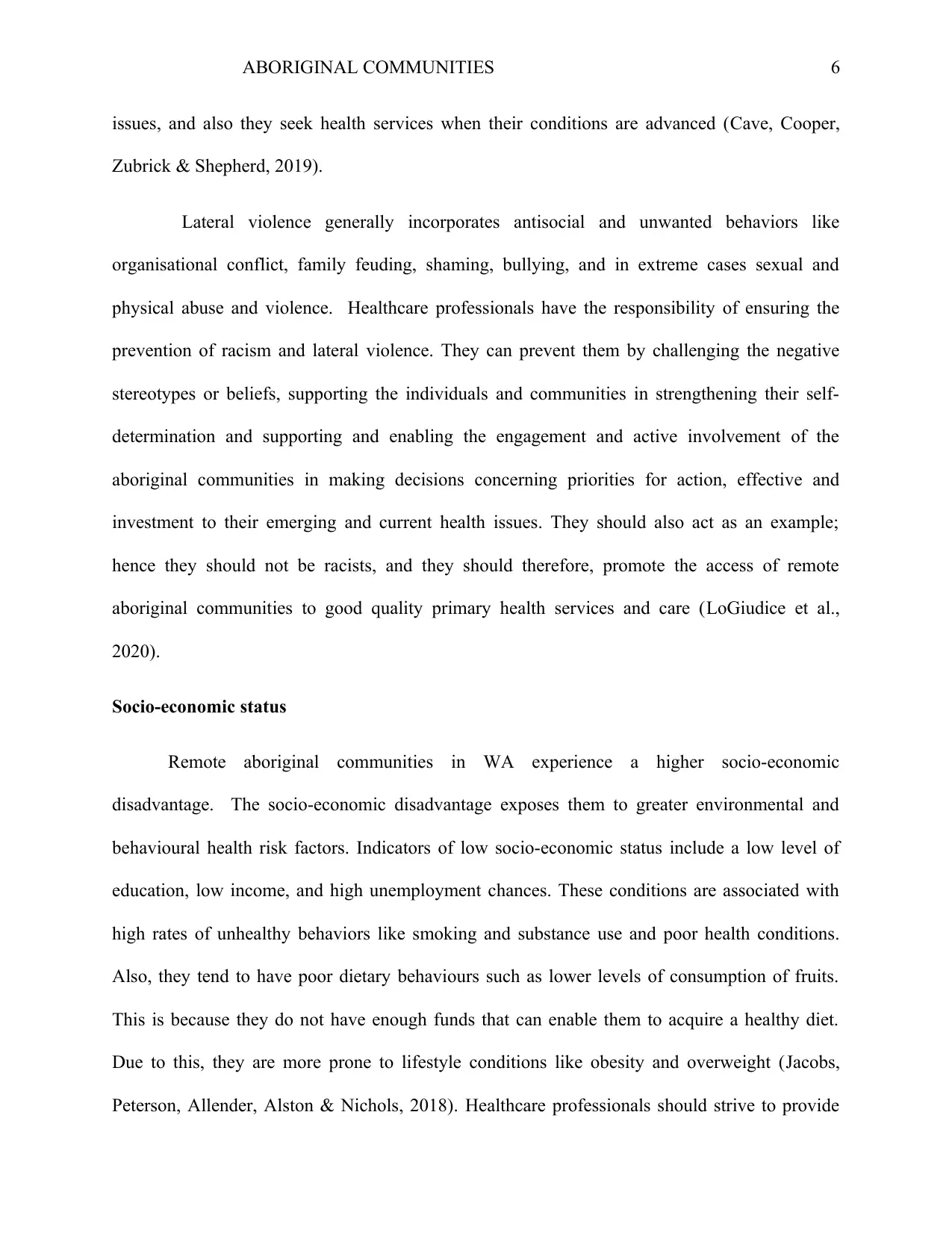
ABORIGINAL COMMUNITIES 6
issues, and also they seek health services when their conditions are advanced (Cave, Cooper,
Zubrick & Shepherd, 2019).
Lateral violence generally incorporates antisocial and unwanted behaviors like
organisational conflict, family feuding, shaming, bullying, and in extreme cases sexual and
physical abuse and violence. Healthcare professionals have the responsibility of ensuring the
prevention of racism and lateral violence. They can prevent them by challenging the negative
stereotypes or beliefs, supporting the individuals and communities in strengthening their self-
determination and supporting and enabling the engagement and active involvement of the
aboriginal communities in making decisions concerning priorities for action, effective and
investment to their emerging and current health issues. They should also act as an example;
hence they should not be racists, and they should therefore, promote the access of remote
aboriginal communities to good quality primary health services and care (LoGiudice et al.,
2020).
Socio-economic status
Remote aboriginal communities in WA experience a higher socio-economic
disadvantage. The socio-economic disadvantage exposes them to greater environmental and
behavioural health risk factors. Indicators of low socio-economic status include a low level of
education, low income, and high unemployment chances. These conditions are associated with
high rates of unhealthy behaviors like smoking and substance use and poor health conditions.
Also, they tend to have poor dietary behaviours such as lower levels of consumption of fruits.
This is because they do not have enough funds that can enable them to acquire a healthy diet.
Due to this, they are more prone to lifestyle conditions like obesity and overweight (Jacobs,
Peterson, Allender, Alston & Nichols, 2018). Healthcare professionals should strive to provide
issues, and also they seek health services when their conditions are advanced (Cave, Cooper,
Zubrick & Shepherd, 2019).
Lateral violence generally incorporates antisocial and unwanted behaviors like
organisational conflict, family feuding, shaming, bullying, and in extreme cases sexual and
physical abuse and violence. Healthcare professionals have the responsibility of ensuring the
prevention of racism and lateral violence. They can prevent them by challenging the negative
stereotypes or beliefs, supporting the individuals and communities in strengthening their self-
determination and supporting and enabling the engagement and active involvement of the
aboriginal communities in making decisions concerning priorities for action, effective and
investment to their emerging and current health issues. They should also act as an example;
hence they should not be racists, and they should therefore, promote the access of remote
aboriginal communities to good quality primary health services and care (LoGiudice et al.,
2020).
Socio-economic status
Remote aboriginal communities in WA experience a higher socio-economic
disadvantage. The socio-economic disadvantage exposes them to greater environmental and
behavioural health risk factors. Indicators of low socio-economic status include a low level of
education, low income, and high unemployment chances. These conditions are associated with
high rates of unhealthy behaviors like smoking and substance use and poor health conditions.
Also, they tend to have poor dietary behaviours such as lower levels of consumption of fruits.
This is because they do not have enough funds that can enable them to acquire a healthy diet.
Due to this, they are more prone to lifestyle conditions like obesity and overweight (Jacobs,
Peterson, Allender, Alston & Nichols, 2018). Healthcare professionals should strive to provide
⊘ This is a preview!⊘
Do you want full access?
Subscribe today to unlock all pages.

Trusted by 1+ million students worldwide
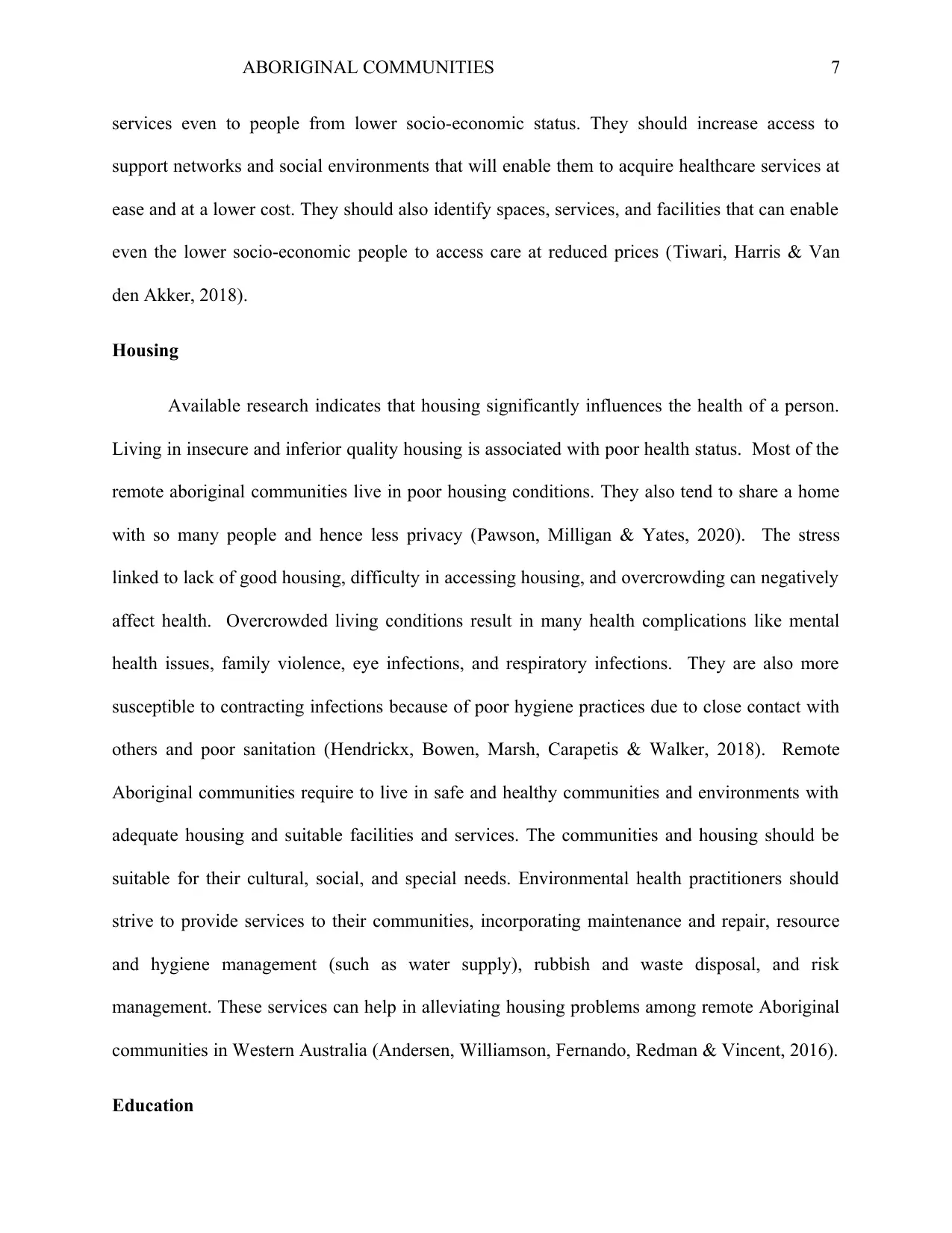
ABORIGINAL COMMUNITIES 7
services even to people from lower socio-economic status. They should increase access to
support networks and social environments that will enable them to acquire healthcare services at
ease and at a lower cost. They should also identify spaces, services, and facilities that can enable
even the lower socio-economic people to access care at reduced prices (Tiwari, Harris & Van
den Akker, 2018).
Housing
Available research indicates that housing significantly influences the health of a person.
Living in insecure and inferior quality housing is associated with poor health status. Most of the
remote aboriginal communities live in poor housing conditions. They also tend to share a home
with so many people and hence less privacy (Pawson, Milligan & Yates, 2020). The stress
linked to lack of good housing, difficulty in accessing housing, and overcrowding can negatively
affect health. Overcrowded living conditions result in many health complications like mental
health issues, family violence, eye infections, and respiratory infections. They are also more
susceptible to contracting infections because of poor hygiene practices due to close contact with
others and poor sanitation (Hendrickx, Bowen, Marsh, Carapetis & Walker, 2018). Remote
Aboriginal communities require to live in safe and healthy communities and environments with
adequate housing and suitable facilities and services. The communities and housing should be
suitable for their cultural, social, and special needs. Environmental health practitioners should
strive to provide services to their communities, incorporating maintenance and repair, resource
and hygiene management (such as water supply), rubbish and waste disposal, and risk
management. These services can help in alleviating housing problems among remote Aboriginal
communities in Western Australia (Andersen, Williamson, Fernando, Redman & Vincent, 2016).
Education
services even to people from lower socio-economic status. They should increase access to
support networks and social environments that will enable them to acquire healthcare services at
ease and at a lower cost. They should also identify spaces, services, and facilities that can enable
even the lower socio-economic people to access care at reduced prices (Tiwari, Harris & Van
den Akker, 2018).
Housing
Available research indicates that housing significantly influences the health of a person.
Living in insecure and inferior quality housing is associated with poor health status. Most of the
remote aboriginal communities live in poor housing conditions. They also tend to share a home
with so many people and hence less privacy (Pawson, Milligan & Yates, 2020). The stress
linked to lack of good housing, difficulty in accessing housing, and overcrowding can negatively
affect health. Overcrowded living conditions result in many health complications like mental
health issues, family violence, eye infections, and respiratory infections. They are also more
susceptible to contracting infections because of poor hygiene practices due to close contact with
others and poor sanitation (Hendrickx, Bowen, Marsh, Carapetis & Walker, 2018). Remote
Aboriginal communities require to live in safe and healthy communities and environments with
adequate housing and suitable facilities and services. The communities and housing should be
suitable for their cultural, social, and special needs. Environmental health practitioners should
strive to provide services to their communities, incorporating maintenance and repair, resource
and hygiene management (such as water supply), rubbish and waste disposal, and risk
management. These services can help in alleviating housing problems among remote Aboriginal
communities in Western Australia (Andersen, Williamson, Fernando, Redman & Vincent, 2016).
Education
Paraphrase This Document
Need a fresh take? Get an instant paraphrase of this document with our AI Paraphraser
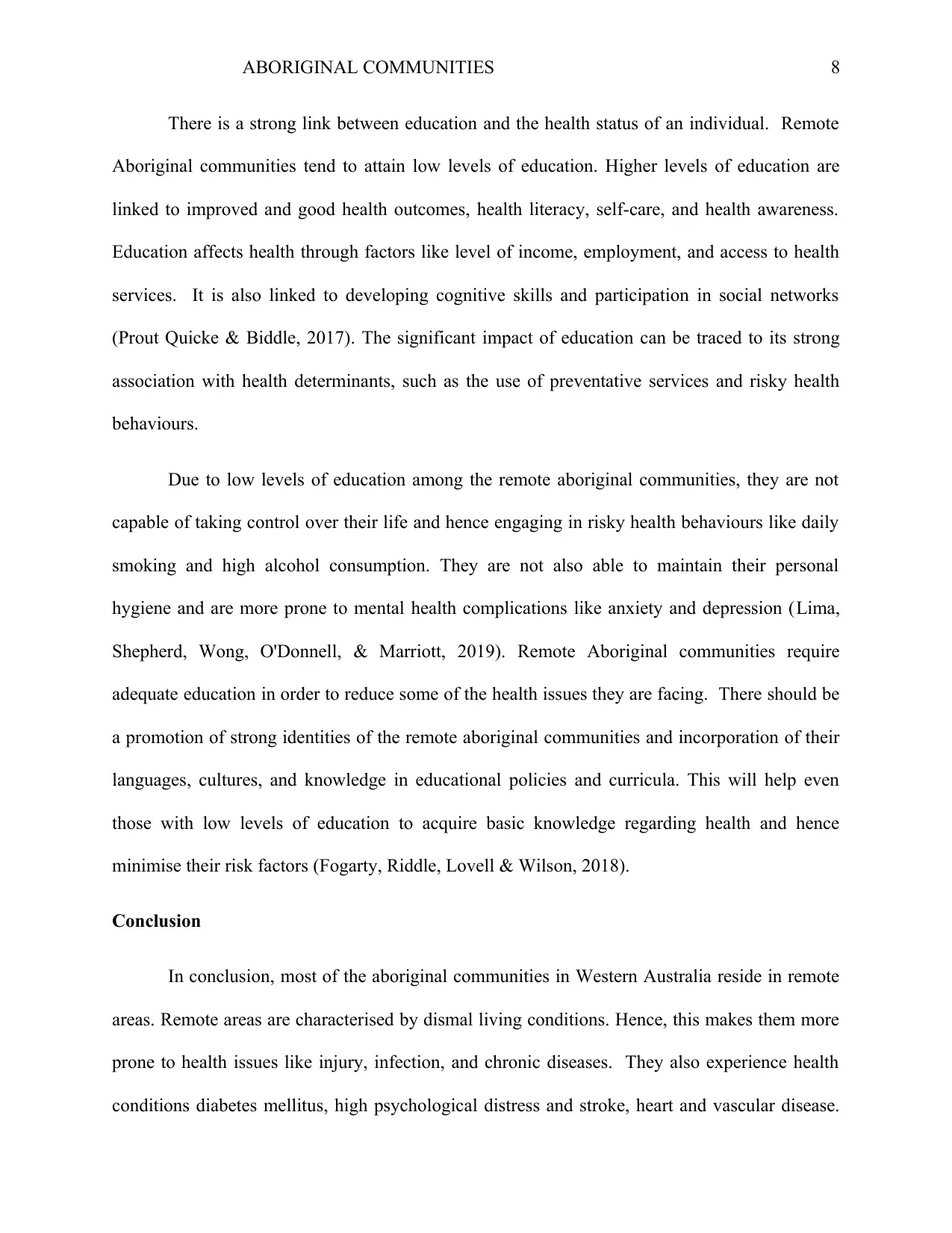
ABORIGINAL COMMUNITIES 8
There is a strong link between education and the health status of an individual. Remote
Aboriginal communities tend to attain low levels of education. Higher levels of education are
linked to improved and good health outcomes, health literacy, self-care, and health awareness.
Education affects health through factors like level of income, employment, and access to health
services. It is also linked to developing cognitive skills and participation in social networks
(Prout Quicke & Biddle, 2017). The significant impact of education can be traced to its strong
association with health determinants, such as the use of preventative services and risky health
behaviours.
Due to low levels of education among the remote aboriginal communities, they are not
capable of taking control over their life and hence engaging in risky health behaviours like daily
smoking and high alcohol consumption. They are not also able to maintain their personal
hygiene and are more prone to mental health complications like anxiety and depression (Lima,
Shepherd, Wong, O'Donnell, & Marriott, 2019). Remote Aboriginal communities require
adequate education in order to reduce some of the health issues they are facing. There should be
a promotion of strong identities of the remote aboriginal communities and incorporation of their
languages, cultures, and knowledge in educational policies and curricula. This will help even
those with low levels of education to acquire basic knowledge regarding health and hence
minimise their risk factors (Fogarty, Riddle, Lovell & Wilson, 2018).
Conclusion
In conclusion, most of the aboriginal communities in Western Australia reside in remote
areas. Remote areas are characterised by dismal living conditions. Hence, this makes them more
prone to health issues like injury, infection, and chronic diseases. They also experience health
conditions diabetes mellitus, high psychological distress and stroke, heart and vascular disease.
There is a strong link between education and the health status of an individual. Remote
Aboriginal communities tend to attain low levels of education. Higher levels of education are
linked to improved and good health outcomes, health literacy, self-care, and health awareness.
Education affects health through factors like level of income, employment, and access to health
services. It is also linked to developing cognitive skills and participation in social networks
(Prout Quicke & Biddle, 2017). The significant impact of education can be traced to its strong
association with health determinants, such as the use of preventative services and risky health
behaviours.
Due to low levels of education among the remote aboriginal communities, they are not
capable of taking control over their life and hence engaging in risky health behaviours like daily
smoking and high alcohol consumption. They are not also able to maintain their personal
hygiene and are more prone to mental health complications like anxiety and depression (Lima,
Shepherd, Wong, O'Donnell, & Marriott, 2019). Remote Aboriginal communities require
adequate education in order to reduce some of the health issues they are facing. There should be
a promotion of strong identities of the remote aboriginal communities and incorporation of their
languages, cultures, and knowledge in educational policies and curricula. This will help even
those with low levels of education to acquire basic knowledge regarding health and hence
minimise their risk factors (Fogarty, Riddle, Lovell & Wilson, 2018).
Conclusion
In conclusion, most of the aboriginal communities in Western Australia reside in remote
areas. Remote areas are characterised by dismal living conditions. Hence, this makes them more
prone to health issues like injury, infection, and chronic diseases. They also experience health
conditions diabetes mellitus, high psychological distress and stroke, heart and vascular disease.
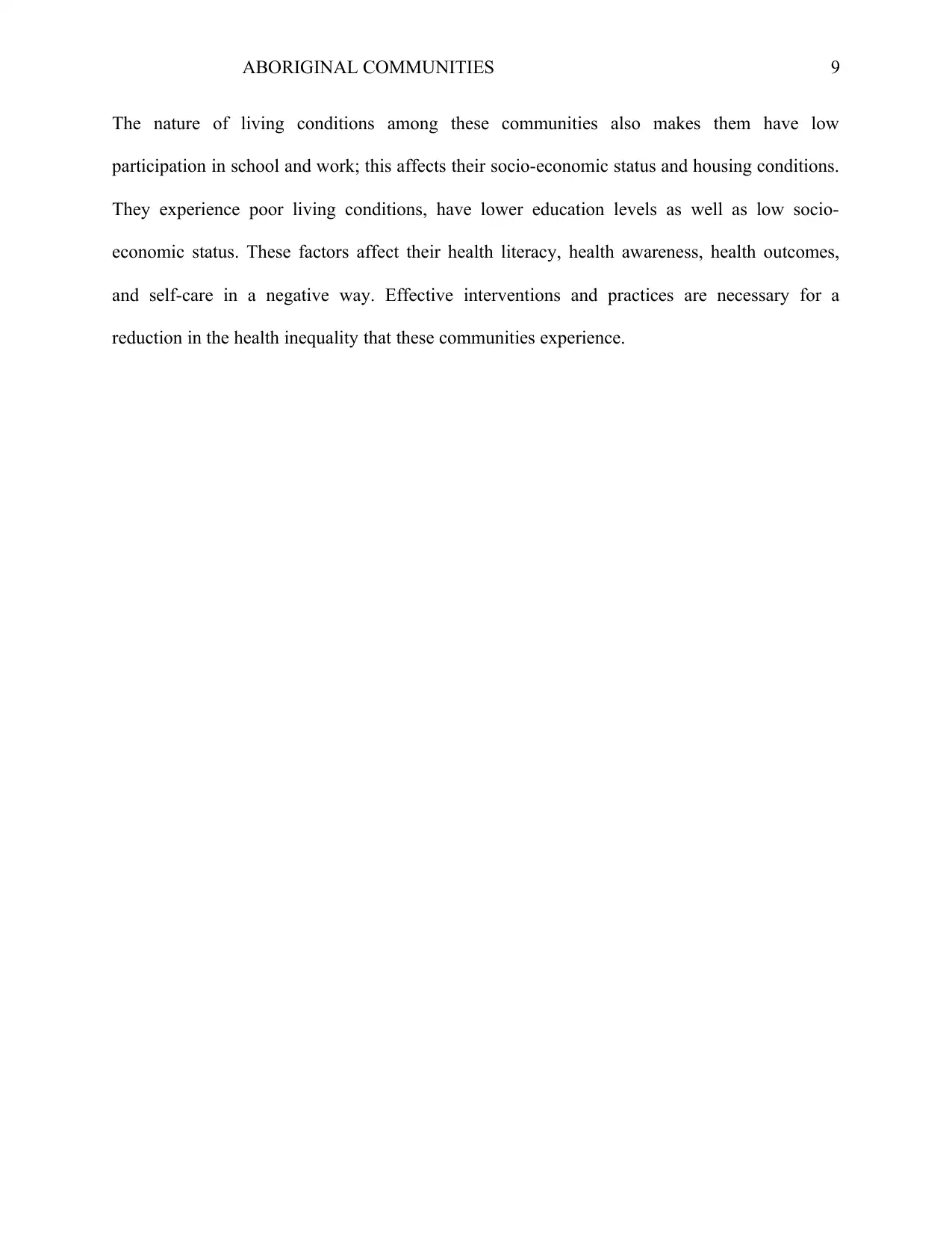
ABORIGINAL COMMUNITIES 9
The nature of living conditions among these communities also makes them have low
participation in school and work; this affects their socio-economic status and housing conditions.
They experience poor living conditions, have lower education levels as well as low socio-
economic status. These factors affect their health literacy, health awareness, health outcomes,
and self-care in a negative way. Effective interventions and practices are necessary for a
reduction in the health inequality that these communities experience.
The nature of living conditions among these communities also makes them have low
participation in school and work; this affects their socio-economic status and housing conditions.
They experience poor living conditions, have lower education levels as well as low socio-
economic status. These factors affect their health literacy, health awareness, health outcomes,
and self-care in a negative way. Effective interventions and practices are necessary for a
reduction in the health inequality that these communities experience.
⊘ This is a preview!⊘
Do you want full access?
Subscribe today to unlock all pages.

Trusted by 1+ million students worldwide
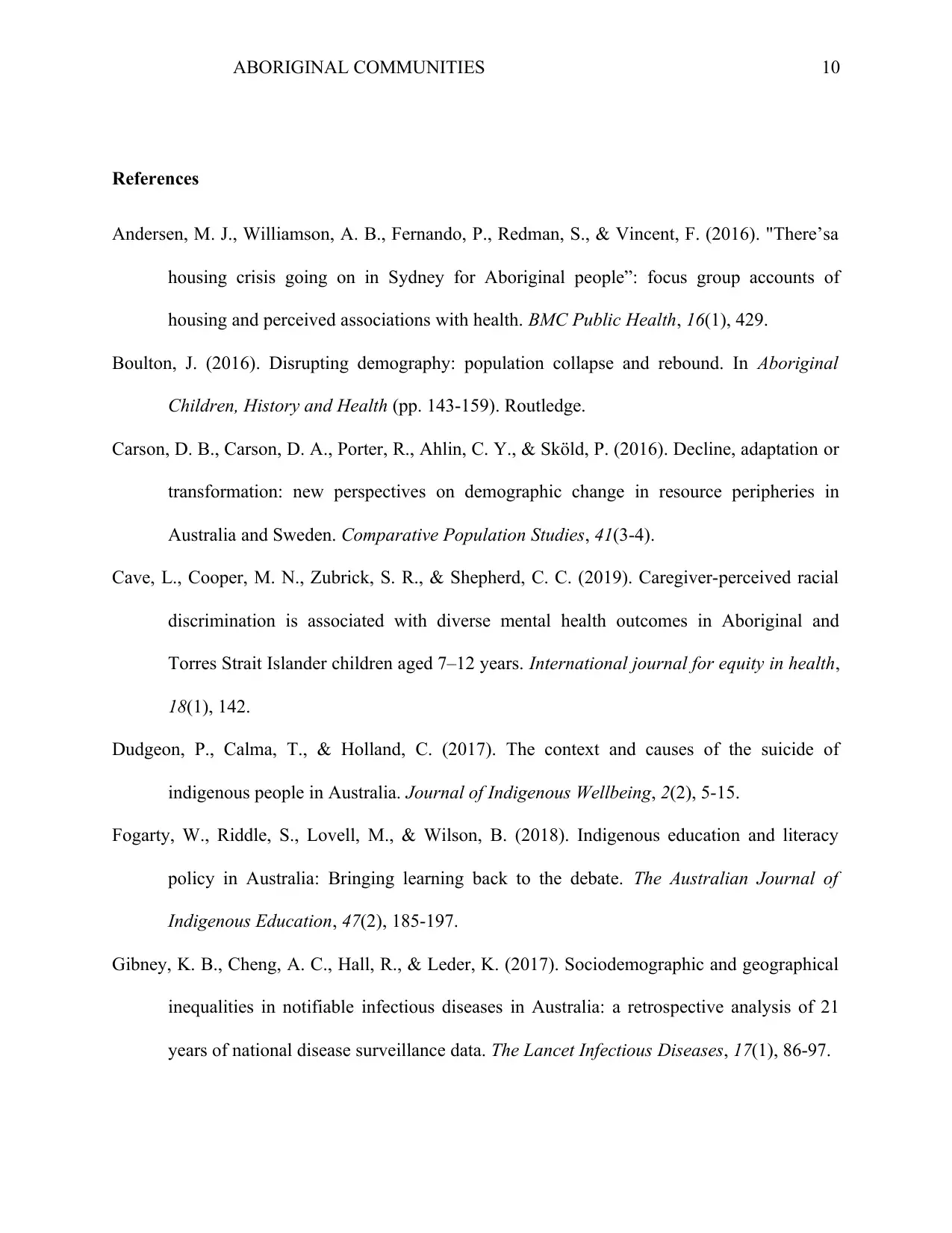
ABORIGINAL COMMUNITIES 10
References
Andersen, M. J., Williamson, A. B., Fernando, P., Redman, S., & Vincent, F. (2016). "There’sa
housing crisis going on in Sydney for Aboriginal people”: focus group accounts of
housing and perceived associations with health. BMC Public Health, 16(1), 429.
Boulton, J. (2016). Disrupting demography: population collapse and rebound. In Aboriginal
Children, History and Health (pp. 143-159). Routledge.
Carson, D. B., Carson, D. A., Porter, R., Ahlin, C. Y., & Sköld, P. (2016). Decline, adaptation or
transformation: new perspectives on demographic change in resource peripheries in
Australia and Sweden. Comparative Population Studies, 41(3-4).
Cave, L., Cooper, M. N., Zubrick, S. R., & Shepherd, C. C. (2019). Caregiver-perceived racial
discrimination is associated with diverse mental health outcomes in Aboriginal and
Torres Strait Islander children aged 7–12 years. International journal for equity in health,
18(1), 142.
Dudgeon, P., Calma, T., & Holland, C. (2017). The context and causes of the suicide of
indigenous people in Australia. Journal of Indigenous Wellbeing, 2(2), 5-15.
Fogarty, W., Riddle, S., Lovell, M., & Wilson, B. (2018). Indigenous education and literacy
policy in Australia: Bringing learning back to the debate. The Australian Journal of
Indigenous Education, 47(2), 185-197.
Gibney, K. B., Cheng, A. C., Hall, R., & Leder, K. (2017). Sociodemographic and geographical
inequalities in notifiable infectious diseases in Australia: a retrospective analysis of 21
years of national disease surveillance data. The Lancet Infectious Diseases, 17(1), 86-97.
References
Andersen, M. J., Williamson, A. B., Fernando, P., Redman, S., & Vincent, F. (2016). "There’sa
housing crisis going on in Sydney for Aboriginal people”: focus group accounts of
housing and perceived associations with health. BMC Public Health, 16(1), 429.
Boulton, J. (2016). Disrupting demography: population collapse and rebound. In Aboriginal
Children, History and Health (pp. 143-159). Routledge.
Carson, D. B., Carson, D. A., Porter, R., Ahlin, C. Y., & Sköld, P. (2016). Decline, adaptation or
transformation: new perspectives on demographic change in resource peripheries in
Australia and Sweden. Comparative Population Studies, 41(3-4).
Cave, L., Cooper, M. N., Zubrick, S. R., & Shepherd, C. C. (2019). Caregiver-perceived racial
discrimination is associated with diverse mental health outcomes in Aboriginal and
Torres Strait Islander children aged 7–12 years. International journal for equity in health,
18(1), 142.
Dudgeon, P., Calma, T., & Holland, C. (2017). The context and causes of the suicide of
indigenous people in Australia. Journal of Indigenous Wellbeing, 2(2), 5-15.
Fogarty, W., Riddle, S., Lovell, M., & Wilson, B. (2018). Indigenous education and literacy
policy in Australia: Bringing learning back to the debate. The Australian Journal of
Indigenous Education, 47(2), 185-197.
Gibney, K. B., Cheng, A. C., Hall, R., & Leder, K. (2017). Sociodemographic and geographical
inequalities in notifiable infectious diseases in Australia: a retrospective analysis of 21
years of national disease surveillance data. The Lancet Infectious Diseases, 17(1), 86-97.
Paraphrase This Document
Need a fresh take? Get an instant paraphrase of this document with our AI Paraphraser
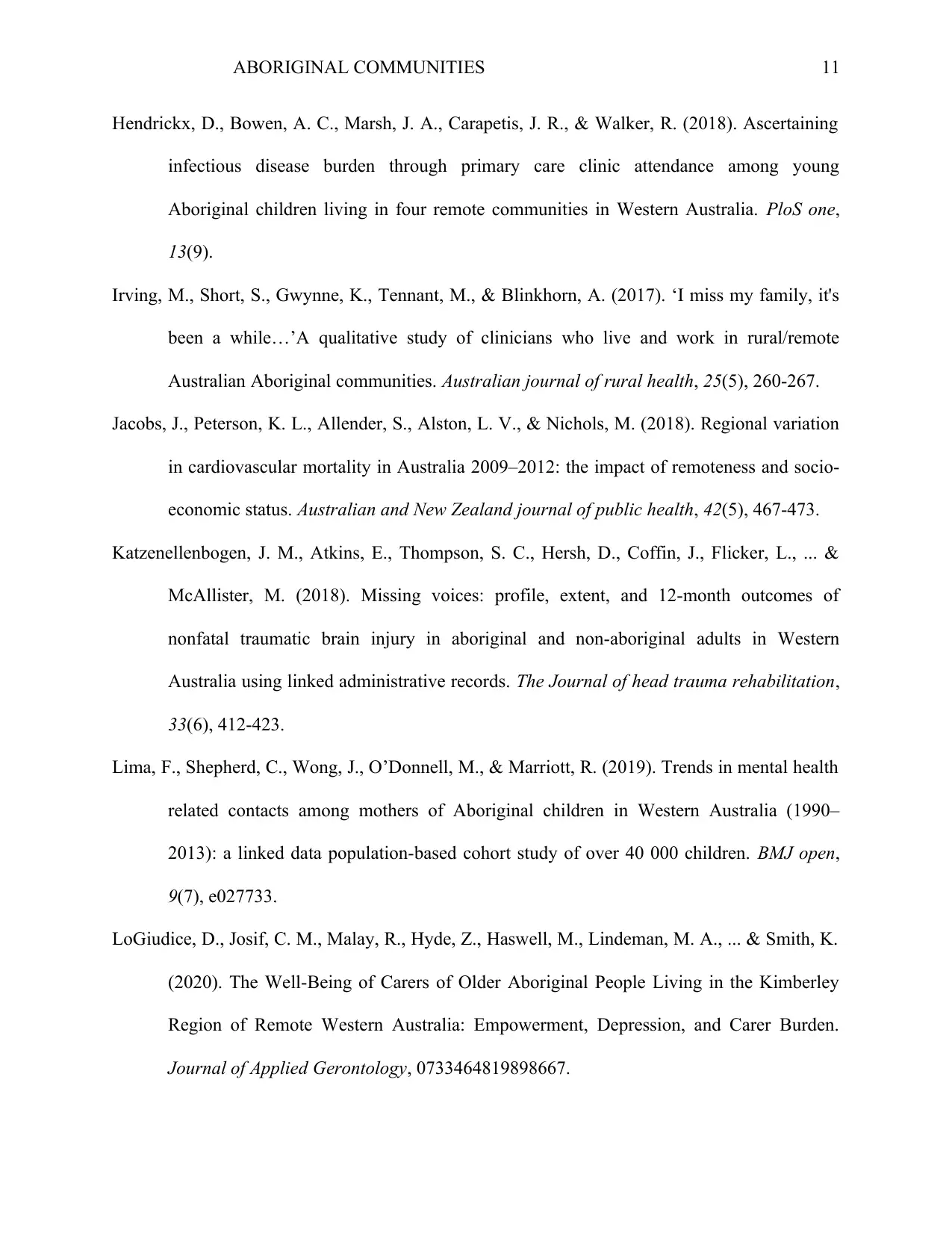
ABORIGINAL COMMUNITIES 11
Hendrickx, D., Bowen, A. C., Marsh, J. A., Carapetis, J. R., & Walker, R. (2018). Ascertaining
infectious disease burden through primary care clinic attendance among young
Aboriginal children living in four remote communities in Western Australia. PloS one,
13(9).
Irving, M., Short, S., Gwynne, K., Tennant, M., & Blinkhorn, A. (2017). ‘I miss my family, it's
been a while…’A qualitative study of clinicians who live and work in rural/remote
Australian Aboriginal communities. Australian journal of rural health, 25(5), 260-267.
Jacobs, J., Peterson, K. L., Allender, S., Alston, L. V., & Nichols, M. (2018). Regional variation
in cardiovascular mortality in Australia 2009–2012: the impact of remoteness and socio-
economic status. Australian and New Zealand journal of public health, 42(5), 467-473.
Katzenellenbogen, J. M., Atkins, E., Thompson, S. C., Hersh, D., Coffin, J., Flicker, L., ... &
McAllister, M. (2018). Missing voices: profile, extent, and 12-month outcomes of
nonfatal traumatic brain injury in aboriginal and non-aboriginal adults in Western
Australia using linked administrative records. The Journal of head trauma rehabilitation,
33(6), 412-423.
Lima, F., Shepherd, C., Wong, J., O’Donnell, M., & Marriott, R. (2019). Trends in mental health
related contacts among mothers of Aboriginal children in Western Australia (1990–
2013): a linked data population-based cohort study of over 40 000 children. BMJ open,
9(7), e027733.
LoGiudice, D., Josif, C. M., Malay, R., Hyde, Z., Haswell, M., Lindeman, M. A., ... & Smith, K.
(2020). The Well-Being of Carers of Older Aboriginal People Living in the Kimberley
Region of Remote Western Australia: Empowerment, Depression, and Carer Burden.
Journal of Applied Gerontology, 0733464819898667.
Hendrickx, D., Bowen, A. C., Marsh, J. A., Carapetis, J. R., & Walker, R. (2018). Ascertaining
infectious disease burden through primary care clinic attendance among young
Aboriginal children living in four remote communities in Western Australia. PloS one,
13(9).
Irving, M., Short, S., Gwynne, K., Tennant, M., & Blinkhorn, A. (2017). ‘I miss my family, it's
been a while…’A qualitative study of clinicians who live and work in rural/remote
Australian Aboriginal communities. Australian journal of rural health, 25(5), 260-267.
Jacobs, J., Peterson, K. L., Allender, S., Alston, L. V., & Nichols, M. (2018). Regional variation
in cardiovascular mortality in Australia 2009–2012: the impact of remoteness and socio-
economic status. Australian and New Zealand journal of public health, 42(5), 467-473.
Katzenellenbogen, J. M., Atkins, E., Thompson, S. C., Hersh, D., Coffin, J., Flicker, L., ... &
McAllister, M. (2018). Missing voices: profile, extent, and 12-month outcomes of
nonfatal traumatic brain injury in aboriginal and non-aboriginal adults in Western
Australia using linked administrative records. The Journal of head trauma rehabilitation,
33(6), 412-423.
Lima, F., Shepherd, C., Wong, J., O’Donnell, M., & Marriott, R. (2019). Trends in mental health
related contacts among mothers of Aboriginal children in Western Australia (1990–
2013): a linked data population-based cohort study of over 40 000 children. BMJ open,
9(7), e027733.
LoGiudice, D., Josif, C. M., Malay, R., Hyde, Z., Haswell, M., Lindeman, M. A., ... & Smith, K.
(2020). The Well-Being of Carers of Older Aboriginal People Living in the Kimberley
Region of Remote Western Australia: Empowerment, Depression, and Carer Burden.
Journal of Applied Gerontology, 0733464819898667.
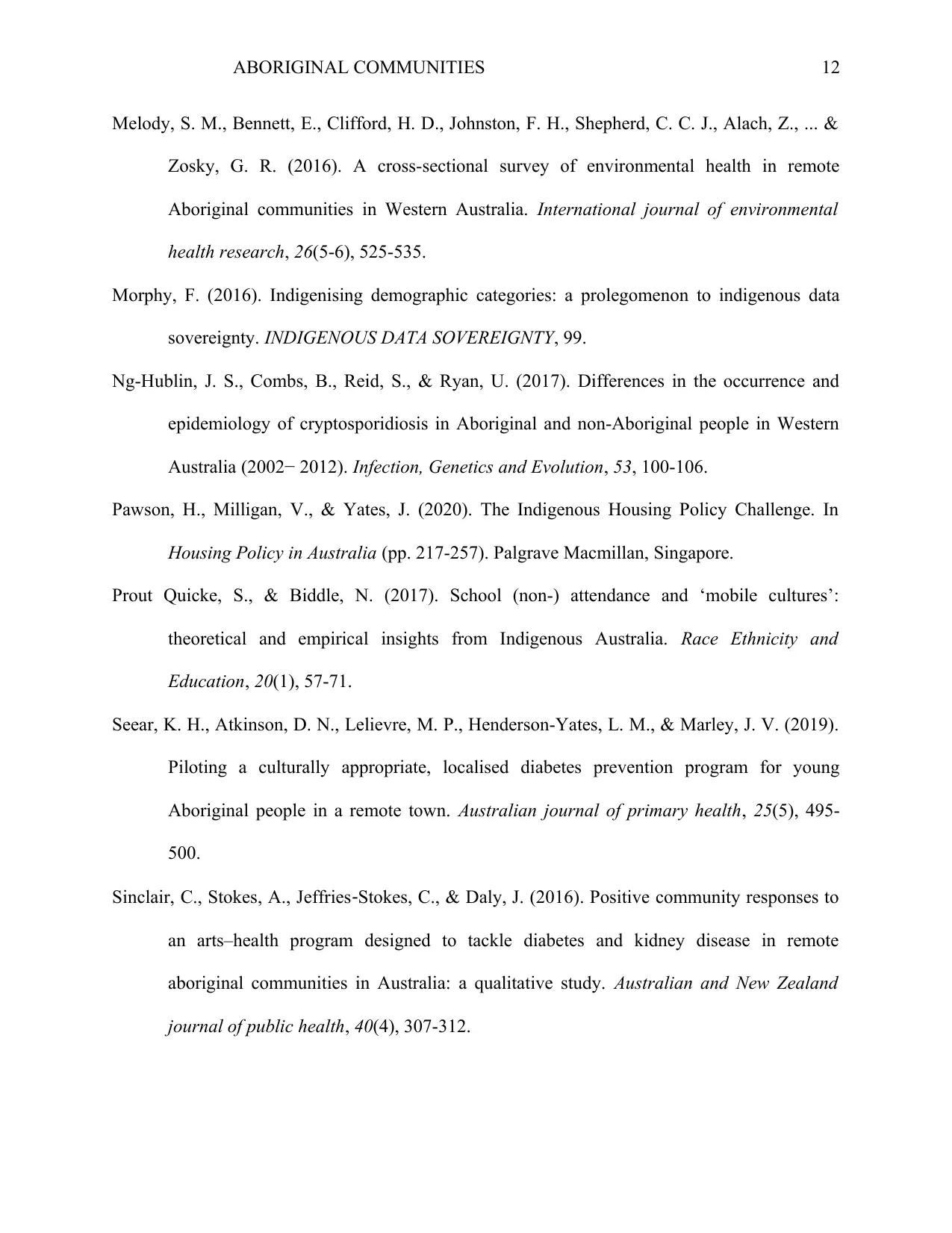
ABORIGINAL COMMUNITIES 12
Melody, S. M., Bennett, E., Clifford, H. D., Johnston, F. H., Shepherd, C. C. J., Alach, Z., ... &
Zosky, G. R. (2016). A cross-sectional survey of environmental health in remote
Aboriginal communities in Western Australia. International journal of environmental
health research, 26(5-6), 525-535.
Morphy, F. (2016). Indigenising demographic categories: a prolegomenon to indigenous data
sovereignty. INDIGENOUS DATA SOVEREIGNTY, 99.
Ng-Hublin, J. S., Combs, B., Reid, S., & Ryan, U. (2017). Differences in the occurrence and
epidemiology of cryptosporidiosis in Aboriginal and non-Aboriginal people in Western
Australia (2002− 2012). Infection, Genetics and Evolution, 53, 100-106.
Pawson, H., Milligan, V., & Yates, J. (2020). The Indigenous Housing Policy Challenge. In
Housing Policy in Australia (pp. 217-257). Palgrave Macmillan, Singapore.
Prout Quicke, S., & Biddle, N. (2017). School (non-) attendance and ‘mobile cultures’:
theoretical and empirical insights from Indigenous Australia. Race Ethnicity and
Education, 20(1), 57-71.
Seear, K. H., Atkinson, D. N., Lelievre, M. P., Henderson-Yates, L. M., & Marley, J. V. (2019).
Piloting a culturally appropriate, localised diabetes prevention program for young
Aboriginal people in a remote town. Australian journal of primary health, 25(5), 495-
500.
Sinclair, C., Stokes, A., Jeffries‐Stokes, C., & Daly, J. (2016). Positive community responses to
an arts–health program designed to tackle diabetes and kidney disease in remote
aboriginal communities in Australia: a qualitative study. Australian and New Zealand
journal of public health, 40(4), 307-312.
Melody, S. M., Bennett, E., Clifford, H. D., Johnston, F. H., Shepherd, C. C. J., Alach, Z., ... &
Zosky, G. R. (2016). A cross-sectional survey of environmental health in remote
Aboriginal communities in Western Australia. International journal of environmental
health research, 26(5-6), 525-535.
Morphy, F. (2016). Indigenising demographic categories: a prolegomenon to indigenous data
sovereignty. INDIGENOUS DATA SOVEREIGNTY, 99.
Ng-Hublin, J. S., Combs, B., Reid, S., & Ryan, U. (2017). Differences in the occurrence and
epidemiology of cryptosporidiosis in Aboriginal and non-Aboriginal people in Western
Australia (2002− 2012). Infection, Genetics and Evolution, 53, 100-106.
Pawson, H., Milligan, V., & Yates, J. (2020). The Indigenous Housing Policy Challenge. In
Housing Policy in Australia (pp. 217-257). Palgrave Macmillan, Singapore.
Prout Quicke, S., & Biddle, N. (2017). School (non-) attendance and ‘mobile cultures’:
theoretical and empirical insights from Indigenous Australia. Race Ethnicity and
Education, 20(1), 57-71.
Seear, K. H., Atkinson, D. N., Lelievre, M. P., Henderson-Yates, L. M., & Marley, J. V. (2019).
Piloting a culturally appropriate, localised diabetes prevention program for young
Aboriginal people in a remote town. Australian journal of primary health, 25(5), 495-
500.
Sinclair, C., Stokes, A., Jeffries‐Stokes, C., & Daly, J. (2016). Positive community responses to
an arts–health program designed to tackle diabetes and kidney disease in remote
aboriginal communities in Australia: a qualitative study. Australian and New Zealand
journal of public health, 40(4), 307-312.
⊘ This is a preview!⊘
Do you want full access?
Subscribe today to unlock all pages.

Trusted by 1+ million students worldwide
1 out of 13
Related Documents
Your All-in-One AI-Powered Toolkit for Academic Success.
+13062052269
info@desklib.com
Available 24*7 on WhatsApp / Email
![[object Object]](/_next/static/media/star-bottom.7253800d.svg)
Unlock your academic potential
Copyright © 2020–2025 A2Z Services. All Rights Reserved. Developed and managed by ZUCOL.





